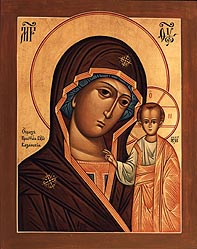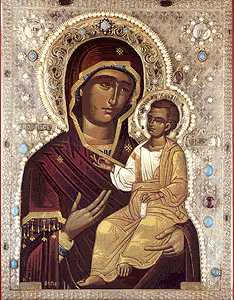Mother of God of Kazan and the Iveron Icon
On July 8, 1579, the Virgin Mary showed a little Russian girl, Matrona, the location of an underground icon in the City of Kazan. Veneration of the
Theotokos of Kazan subsequently was credited with Russian victories over
the Poles (1612), Swedes (1709) and Napoleon (1812). The icon was stolen for its jewels and gold in 1904 and was rumored to have been destroyed by the thieves.
However, conflicting accounts have it in the possession of the Russian Orthodox Church abroad as well as the Catholic Church (which returned that icon to Russian in 2004).
It is often considered the most popular Russian icon.

The
Mother of God of Iveron (gatekeeper) was painted by St. Luke and brought to
Constantinople. The icon was slashed on the Virgin's cheek during the iconoclast period
and bled (the scar remains). A widow came into possession of the icon and cast it into
the sea to save it from further desecration. Around 999 it was rescued from the sea by
St. Gabriel, a monk at Mt. Athos in Greece.
The icon miraculous moved itself to the gate of the monastery and it was revealed that
the Virgin wanted to be the protectress of the monastery Thus began a tradition of having
copies of the icon placed on the gates of Orthodox monasteries.



|